






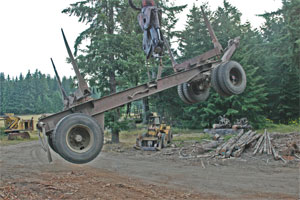



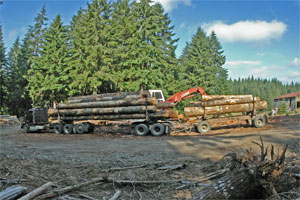

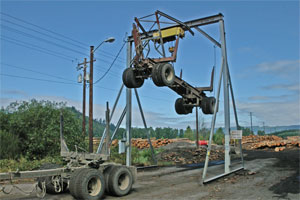
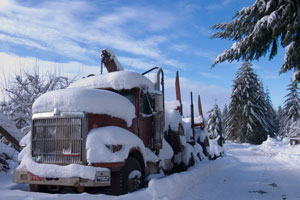
Shown here is a current state of the art Pacific Northwest configured Log Truck. This 1990 model features a set back front axle and a 425 hp Cat engine. This high torque rise engine, 18 speed Road Ranger Transmission, and 2 speed rear end provides an ideal specification for a Western Highway logging truck. At least we assume you would call it a 1990 model. Maybe it should be called a 1989 model. Anyhow the date of manufacture was 12/89 and we took delivery on it new in April of 1991. Truck sales were slow in those years, it seems. A multi-stage Jacobs Brake on the engine provide engine braking capability at all speeds.
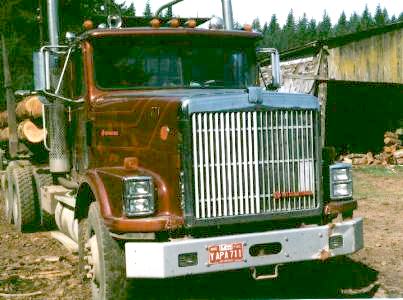
|
Logging trucks are seldom away from home overnight, so sleeper cabs now common on 'over the road' trucks have no relevance and do not appear on Log trucks. Long nosed conventional are popular because they ride better than Cabovers on rough roads and provide plenty of space for a big engine. They are also frustrating because the nose is so large that things as large as cars can hide behind the nose immediately in front of you. You will see some trucks with a sloped nose to help visibility but with the high horsepower vehicles the 'big nose' is needed to provide space for the radiator. In the Pacific Northwest, Kenworths are clearly the dominant brand of log truck found on the highways, but if you look you can find just about everything else. Although nationally Navistar International is a popular brand with major market share, Navistar has been particularly successful in fleet marketing and since most log trucks are owner operators, that advantage has been a disadvantage. Log Trucks are fairly low mileage vehicles---You have to work really hard to put 40,000 miles a year on a log truck and so it is not uncommon for operators to buy a retired long haul fleet truck and refit it for log hauling. The refitted trucks don't make the best log trucks as there are differences in the specs. For example a log truck needs a long wheel base----254" or even more works very well. Shorter wheel base trucks have more problems getting the wheel base needed to comply with the weight laws. In another difference the log trucks if speced for a log truck will have 18 speed transmissions and locking rear ends (for traction), and are typically provided with a rear end ration a bit slower than a highway truck. Finally, a log truck needs a lot of frame sticking out behind rear axles for the stinger. If the truck has been a semi-tractor---they are typically bobbed off short on the back. There is a reason for this. Log trailers are typically steered. The rear overhang is what does the steering. When the truck turns right, the back of the truck goes left, swinging the front of the trailer to the left, thus encouraging the back of the trailer to track near where the truck went instead of cutting the corner. This action works very well if the pintal hitch is 10 feet or so behind the pivot point on the truck.
If you look at the various photos on this page you will see the same truck in several configurations. It is set up for a quick change and can be re-arranged in an hour or so. The top left shows the mule train configuration with the trailer loaded. This configuration will haul a stack of logs on the truck and another stack of logs (typically 16-24 feet long) on the trailer. This is called a "Mule Train". The photo right below it shows the same truck pulling 'doubles' or a super train. In this configuration 2 trailers are pulled. the first trailer is a conventional stinger steered log trailer. The truck has one bunk and the logs (32-40 feet) form a bridge load from the truck to the trailer. The second trailer is the same 4 wheel wagon you see in the mule train configuration. A more common 'long log' configuration is to simply pull the first trailer only and not pull the second trailer, although the 'doubles' are becoming more common. When you are empty, you will haul one trailer and drag the other. In yet another configuration you see long logs bridged to the 4 wheel wagon. This can provide some weight benefits because under the bridge formula, tandem axles are limited to 34,000 lbs for the pair of axles and a 4 wheel wagon can haul 20,000 lbs on each axle. That is a gain of 6,000 lbs, but then the trailer is heavier by 3,000 lbs so the gain is not as much at it appears at first blush. Where it can work very well is when there is an occasion to move extra long logs (those longer than 40 feet). Then you can get the overall wheel base needed for the high gross. Although we have used this combination of and on as market conditions required for over 25 years, it is a very rare combination.
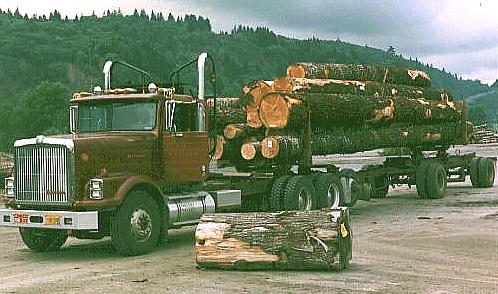
|
In logging applications trucks are usually on short hauls, but often clock many miles on steep winding twisty roads, both public and private. Over the years Loggers have used every kind of a truck made and every kind of a truck engine---usually the most powerful engine they could find. When this truck was made the biggest thing on the the road was a Cat 3406B at 425 HP and that is what it has. Now most new trucks ordered for the logging industry have over 500 hp. with some going to 600. They will not only goo up the hills faster, they will go down the hills faster because the Jake Brakes have more output--often enough that the truck can safely go down a hill at the speed limit. The long historic problem with trucks has been that on down hill runs the friction brakes overheat and fail resulting in a run away truck---not a good thing. The Engine brakes convert the engine into a device that holds the truck back going down the hill so you don't have to use the foot brakes. If it is strong enough to hold the truck back in high gear, then you can go down the hill in high gear saving your foot brakes for emergencies. This is a good thing. Before the days of engine brakes loggers would put a water tank on the truck and when going down the hills they would turn the water on which would squirt on the brake drums to cool them. This kept the brakes from overheating, but not from wearing out.
The long line of photos on the left show the load cycle of a super train in its most simple configuration. In this load cycle the second trailer is loaded on the truck when empty and at the loading location, it is lifted off the truck with the shovel and set to the rear to be hitched to the back of the first trailer. Both trailers are then loaded over the side with logs (Many operators prefer to load a standard log truck over the rear). The load is then wrapped up and delivered to the mill. Actual hitching is simplified because the tongue has a telescope in it, so if you can set the trailer down 'close' to the pintal you can swing the tongue by releasing the air in the front trailer axle so the tires will roll and extend the tongue and make the connection. A tag line runs from the tongue back to the trailer lift strap so the when you pick up the trailer, the tongue flips up, and you can let it down to just the right height for hitching once the trailer is back on the ground.
There are reasons why the operator may wish to load the first trailer and tow the second one. We have trailer rides for both so it can be done either way. If the front trailer is to be loaded it is just set over the stakes like most long loggers, and the second trailer is rehitched to the truck. I avoid it as it is extra hitching, but there is good reason in some circumstances to do that. Much of it has to do with turning around when you get to the loading area. If the second trailer is loaded, then you need space at the loading area to turn the truck around with the 1st trailer behind it. If that space is not available, then you load the first trailer on the truck at the mill, and drag the second trailer. Then you drive up to the shovel in the woods forward, and the shovel sets the 4 wheel wagon out of the way. You can then back away from the shovel still carrying the first trailer and find a turn around that is only big enough for the truck, and turn around and back up to the shovel in the conventional manner. Once the truck and first trailer are loaded you can pull ahead, and the second trailer can be retrieved by the shovel from what ever creative place it was stored in the interim--often on top of a log pile, and it can be hooked up and loaded. It's a way to turn around with 2 trailers in a place there you can't turn around with even 1 trailer and in the real world those are the norm.

|
Trucks after they are loaded in the woods have to be unloaded. Here you see your basic fork lift (a diesel electric Letourneau) easily taking a full 50,000 lb load of logs off a truck in a single bite. This electric motor design has been around the logging industry for a long time. In deed, LeTourneau was making heavy equipment controlled with racks and electric pinions long before the hydraulic machines were on the market. See our loader page In times past logs were 'dumped'. In deed you will hear trucks speak of dumping a load of logs at the dump. Now more than likely that means that a big fork lift grabbed the load and drove off with it. In times past however the descriptions of 'dumping' was more accurate. The stakes on the truck used to be designed so they could be dropped, so to unload you would drive up to the edge of something---often a dock with just a brow log on the outside between you and the water. You would drop remove the binder chains and drop the stakes on the brow log. this would result in most of the logs falling off the truck, and the remainder would be scraped off with a line that was passed under the load and hooked to the brow log before you dropped the stakes. In this system there was typically an A-Frame leaning over the truck so when the line was pulled tight it would parbuckle the logs off the truck and over the brow log and typically into the water. The enviros complained that dropping the logs in the water scared the fish so now most logs are handled on dry land, and if the logs are to go in the water, slings will be passed under the load and the load will be picked up and set in the water with a large crane.